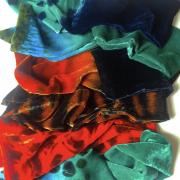When photographer Wendy Hicks saw a controversial advertisement for the fashion label Ralph Lauren it gave her an idea. Sheena Grant reports
When photographer Wendy Hicks saw a controversial advertisement for the fashion label Ralph Lauren it gave her an idea. Sheena Grant reports
The image of model Filippa Hamilton had undergone such a dramatic transformation to make her already slender size 8 frame seem even thinner that her head actually appeared wider than her waist. Wendy quickly realised that such digital alteration wasn’t uncommon in fashion photography and advertising and was concerned that it wasn’t just the images that were being manipulated – so too were the minds of vulnerable young people who were falling prey to eating disorders in pursuit of something that was actually unreal and unattainable.She decided to highlight the issue by exploring how media representations of extreme thinness might affect not only these vulnerable young people but all women and increasingly men too, with a series of digitally-altered images of her own.The project formed the final part of her photography BA at University Campus Suffolk and resulted in an exhibition of ten subtly-enhanced pictures intended to provoke thought about anorexia and its causes.She called it ‘Fashioning Aspirations’ in order to further illuminate the fact that advertisements fashion the aspirations of those who view them.But Wendy did more than just take the pictures. She also carried out a lot of research into where the Western obsession with stick-thin body shapes comes from and just why and how we are all being conditioned into equating thinness with success, wealth and desirability.“Images of Victoria Beckham were my initial inspiration for the project,” says Wendy. “Is her thinness the result of some illness or does she want to appear this way? If the latter is true then why would she perhaps think this is desirable. Is this somehow related to images projected by the media?”As her starting point Wendy photographed ten “ordinary” people, friends and acquaintances who she asked to dress themselves as if they were appearing in a magazine advertisement selling clothes. By doing so she hoped to root the photographs very much in 2010.According to the latest statistics, 90 per cent of those affected by the illness are female so nine of her subjects were women and one a man. As anorexia is most likely to strike during mid teenage years, most of her models were teenagers.
“These images have been modified to create seductive body shapes that in reality are impossible to emulate as they do not actually exist.”
When taking the photographs she copied the style and setting of the magazine photographs she was trying to emulate and in reducing their size through digital manipulation she narrowed the hips to skeletal proportions. The images are not shocking. Wendy wanted them at first sight to appear almost seductive but on closer inspection to morph into the grotesque parody of reality they actually represent.“These images have been modified to create seductive body shapes that in reality are impossible to emulate as they do not actually exist,” she says. “This type of imagery has the effect of destabilising the way we feel about our bodies and is considered one of the contributory factors that lead to eating disorders.”As if to prove just how much we have all been sucked into this way of thinking – even those of us who do not have an eating disorder – one of Wendy’s models admitted she was delighted with the air-brushed image of herself, telling the photographer: “You’ve taken 30lb off me!”“None of them were big people to start with but even I think they look better after their images are altered,” says Wendy. “You just can’t help it. We all get pulled into this myth that has been created about body image.”As part of her project she also wrote a dissertation about the subject, looking at the devices advertising and the consumer society uses to hook us in – and has done as far back as Victorian times.“Its premise is envy of lifestyle and the use of role models, which these days are not people who have achieved anything great but those who have celebrity and wealth,” says Wendy. “It comes down to the idea of selling stuff and these body shapes are in fashion at the moment.“Evidence suggests that Western culture and particularly the media promotes extreme thinness as the epitome of body perfection, success and happiness. This leads to people becoming dissatisfied with their own bodies, their self-esteem suffers and they turn to dieting as they feel the pressure to be thin.“I just want to make people aware. Most of us don’t fall for it: we see through it, but sometimes people do fall for it and if just one of them could stop and see how they are being manipulated it would make the project worthwhile.”And, she says, for anyone willing to look closely at images of models in advertising posters and magazines there are always tell-tale clues that give away the interference of the airbrush. Often, the hands of the models on manipulated images will look ridiculously large in relation to their hips. The ten altered photographs Wendy produced have been on display at a degree show in Ipswich and an exhibition in London. Wendy chose not to include the models’ “before” shots in the show as she felt that would detract from what she was trying to achieve in allowing people to examine the subtleties of her work before arriving at their own conclusions.The photographs are currently being looked at by the renowned psychotherapist and campaigner Susie Orbach and her collaborators with a view to inclusion in a summit planned for next year to challenge the way women’s – and increasingly men’s – bodies are portrayed and the damaging effect this is having on us all.
To find out more log on to www.harrisonhicks.com


























